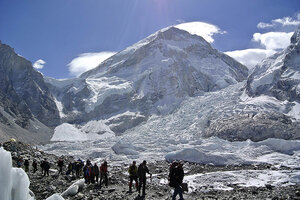In a warming world, more rain can mean less water
Countries 'may need to prepare for a world where the snow reservoir no longer exists,' researchers say, highlighting the challenges of both too much water and not enough.

Mount Everest climbers walk back to their helicopter after a cancelled expedition in April 2014. Mountainous regions around the world, including the Himalayas, are trying to prepare for changes in water availability as snowpacks melt.
Phurba Tenjing Sherpa/ Reuters/ File
As California enters its fifth year of severe drought, and as the state pumps more and more groundwater up to the surface, Central Valley farmers watch their fields literally sinking.
They may not think they share much in common with rice growers in Bangladesh, or Sherpas in Tibet, but they are united by one common phenomenon: mountain snowmelt.
In a study published in Environmental Research Letters on Thursday, a team led by Columbia postdoctoral fellow Dr. Justin Mankin predicts just how, and how much, regions around the world will feel the impact of changing snowmelt as global warming frequently turns snow into rain, especially along the globe's major mountain chains.
Snowpacks on peaks from the Rockies to the Himalayas provide water to vast basin regions, particularly in the Northern Hemisphere: the researchers looked at data from over 400 areas, but just 97 of those house more than a quarter of the world's population. Those same 97 places have at least a two-thirds chance of losing water, thanks to changes in snowmelt.
It seems paradoxical: shouldn't more rain lead to more water? But scientists say it's all about timing.
When snowpack melts gradually, it tends to provide the most water right when people need it, during warmer weather. Quicker, more intense water flowing from mountainous areas could pose a challenge for countries to capture and store that water for use year round : major reservoirs, for example, are expensive. What's more, increased snowmelt can also lead to flooding.
For countries that can successfully channel that water, melting snowpacks may be a boon, at least temporarily. But long-term, the researchers warn, "Water managers in a lot of places may need to prepare for a world where the snow reservoir no longer exists," such as, potentially, the Rocky Mountains.
Whether melting snowpacks lead to more or less water varies by region, with 90 percent showing a likelihood of change; the difficulty is in predicting which kind, and, consequently, planning how to adapt to meet people's water needs.
"Both of those outcomes are entirely consistent with a world with global warming," Dr. Makin explained in a release from Columbia's Earth Institute.
Climate change's rising-sea scenarios worry many environmental scientists, but the consequences are also serious farther inland.
In 2013, the Proceedings of the National Academy of Sciences (PNAS) published a study from the Potsdam Institute which estimated that a 2 degree Celcius temperature increase could throw 40 percent more people into "absolute water scarcity," leading to a host of problems beyond the obvious: health care, education, and business all take a hit when clean water is hard to find.
Security experts are also eyeing water levels, wondering if competition over scare resources will fuel violent conflicts. Another PNAS study even suggested that drought, which drove many rural Syrians into cities between 2006-2010, exacerbated the tensions that exploded into civil war in 2011.
Yoshihide Wada, who studies water resources at the Netherlands’ Utrecht University, suggests that smarter irrigation, water recycling, and crop changes may help water-scarce countries adapt to the new reality.
Those can be expensive investments. But skeptical or cash-strapped governments may be persuaded by a statistic from the World Health Organization: every dollar invested in safe water supplies returns $3 to $34, thanks to improved health, which increases attendance at school and on the job.

